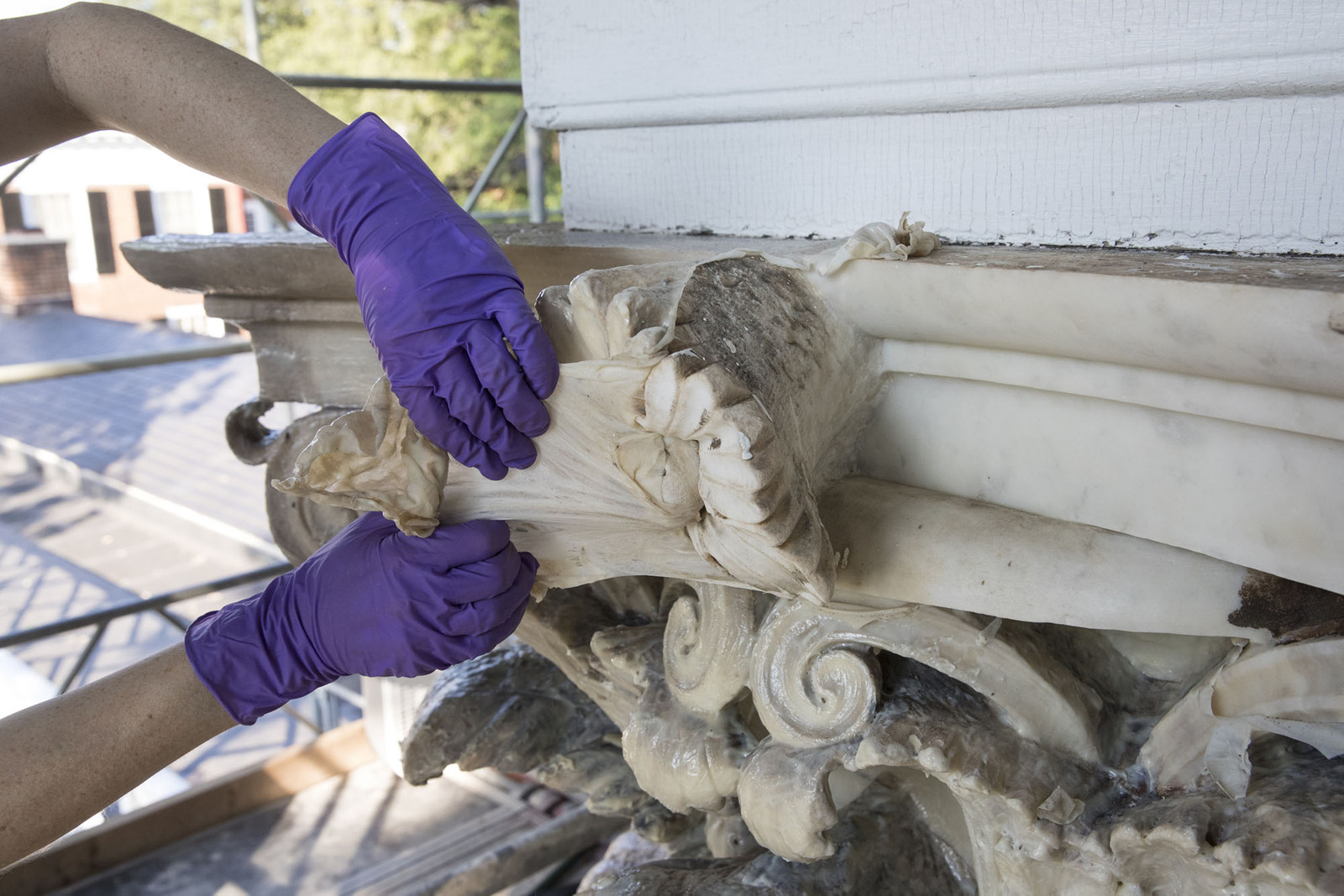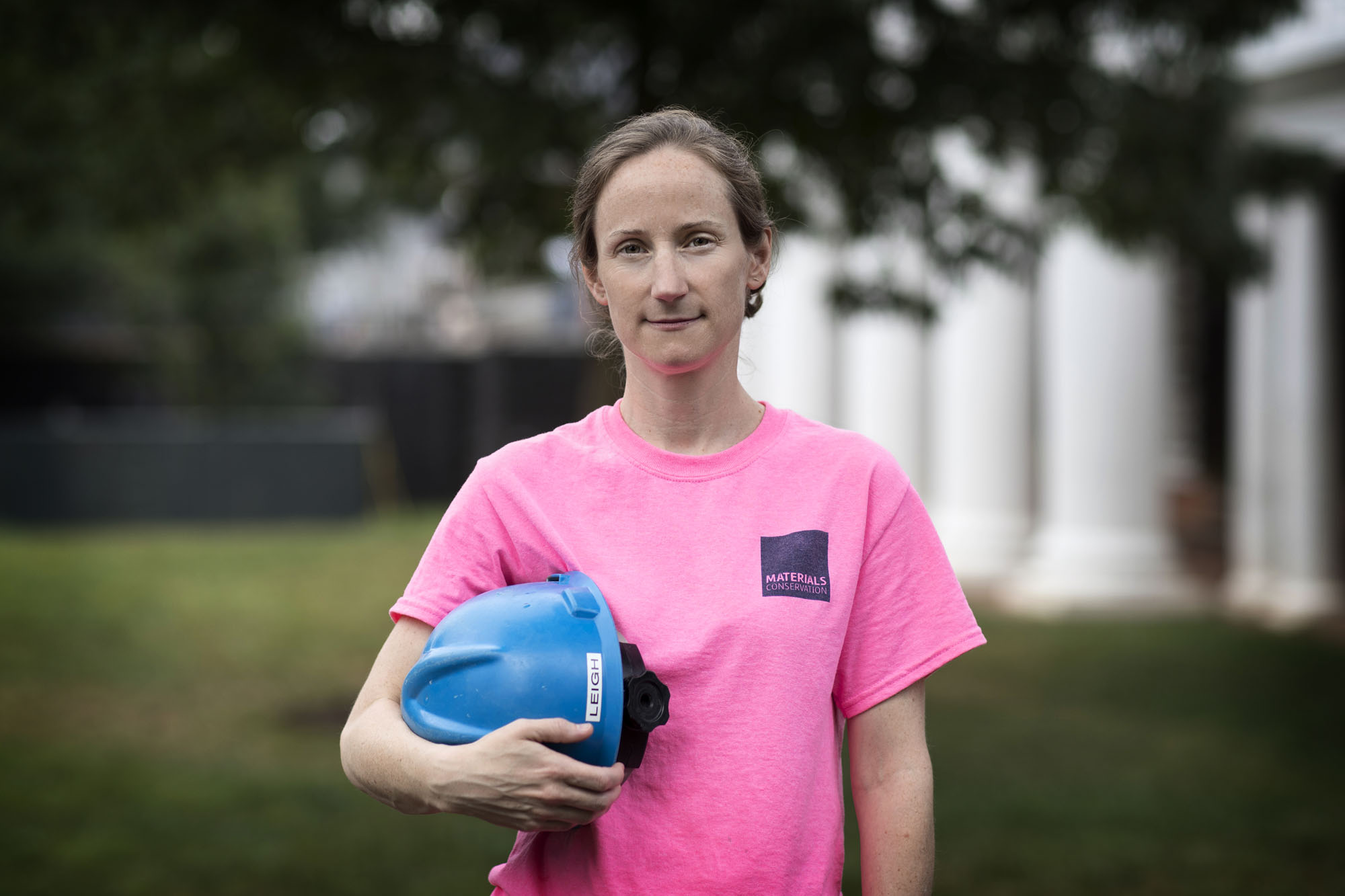For one member of the Philadelphia-based conservation team working on cleaning and repairing the marble capitals at Pavilion III on the University of Virginia’s Lawn, the task is particularly meaningful.
Leigh Hassler, a 2000 graduate of UVA’s School of Architecture, is leading a team from Material Conservation Co. Inc. that is doing the painstaking preservation work on the 1820s-era Carrara marble capitals and their pedestals. It marks the fifth time she has returned to Grounds in her professional capacity.
Her team closely examines each capital to determine what it needs – especially the underside areas not washed by the rain, where pollutants accumulate and bond with the marble. Once these determinations are made, the team has an arsenal of methods to clean and preserve the marble.

Leigh Hassler cleans one of the marble capitals at Pavilion III. “It certainly feels more personal than my other jobs,” she said. “I feel a little sense of ownership.” (Photos by Dan Addison/University Communications)
Hassler recently sat down with UVA Today to talk about her career, her work and the special meaning it holds for her as an alumna.
Q. What is the work you are doing on Pavilion III?
A. Basically, we are performing important maintenance work, so these original Jefferson Corinthian capitals do not suffer the same fate as the Rotunda capitals.
On a more technical level, there is a cleaning phase and then a stabilization phase. We are cleaning off the general soiling and the much more damaging gypsum alteration crust. Gypsum crust is when the calcium carbonate of the stone reacts with sulfur dioxide in the air to form calcium sulfite, which is very damaging. These are the very black areas you see on the capitals.
To remove it, we have applied a latex cleaning product. It goes on as a really thick liquid and it is painted on; there is a polymerization and it turns into rubber, so we essentially just peel it off and it takes dirt with it. But it also loosens what is below and you can scrub it off much more easily. What is not removed with the latex, the very stubborn areas, we will remove with laser cleansing as we did at Pavilion II.
The laser cleaning is a process where the black material, which is the crust, absorbs the laser beam at a much higher rate and it essentially vaporizes, whereas the white marble reflects it, so it is a very effective cleaning tool, especially for more fragile areas. That is the cleaning phase.
In the stabilization phase, we will be filling cracks and consolidating, which will improve the grain-to-grain cohesion of the marble, without compromising it in terms of its breathability, or things like that that would jeopardize it in any way. These columns are in really good condition, given their age. It is very nice to find them in such good condition.
It is very tedious work. It takes a long time, but we have a good team and it’s a great project. I am happy to be here.
Q. What is it like to come back to your old school to do work such as this?
A. I love working down here. Charlottesville just keeps getting cooler. I think anyone who has spent four years here definitely feels a connection to these buildings on the Lawn, these original Jefferson buildings, and it certainly feels more personal than my other jobs. I feel a little sense of ownership.
Q. How did you feel about these buildings when you were just a student here?
A. I studied architectural history, so I think I may have had a higher level of appreciation when I was here than some who did not spend as much time with them as I did. I certainly look at them differently now that I have studied them professionally and taken it to another level.
Q. Is there a sense of being a part of history working on the Lawn?
A. Of course. I consider UVA’s Grounds and Jefferson’s vision and architectural exploration to be up there with the most important in our history.
Also, there is something that is personally special to me in that my dad went here and my older sister went here, so I have been coming here since I was little; we are from Philadelphia, so I have been making the trip down here for a long time.
It is really a special place. It feels really personal, like I am working on something close to home. I think there is a certain continuity from when I was here as a student.
Also, it is so great to work with the UVA staff. I really appreciate how knowledgeable and involved they are. You don't see that level of understanding and commitment everywhere.
Q. Did you imagine when you were a student here that you would be coming back to work on things such as this?
A. No, I certainly didn’t. I had an idea what I was going to be doing in terms of my career, but I did not know I would be back working on these buildings. I had a focus – I just needed to find out what my skill set was.
Right out of UVA I worked in the non-profit world for the National Trust for Historic Preservation in Boston. I was at a desk and I did grant administration, and I realized I would much rather be on the hands-on side of things. Doing project-based work and hands-on work is much more satisfying to me. It took a little while to figure out what I wanted to do and I did go back to study architectural conservation. But I always kind of knew what path I was on, in a way.
Q. What are the other buildings on Grounds on which you have worked?
A. The first one I worked on was Pavilion II, and then I surveyed the Rotunda capitals, the old ones, and then I did a survey of the sandstone stairs; my firm worked on Pavilion X, but I was on maternity leave then. More recently, we worked on Old Cabell Hall.
Q. What are some of the other projects on which you have worked?
A. We do a full range. On the larger side, we have worked on the Supreme Court of the United States and the New York Public Library. We work with several other universities, such as Yale and the University of Pennsylvania. Because we are based in Philadelphia, a ton of our work is there – Eastern State Penitentiary, the Rodin Museum of the Philadelphia Museum of Art, Philadelphia City Hall. We worked on the multi-year restoration of the A.I. DuPont residence Nemours, and the subsequent maintenance.
On the smaller side, we work on a lot of gravestones and outdoor sculpture. We also always seem to be working on fountains; they take a real beating given the exposure.
Media Contact
Article Information
August 5, 2016
/content/alumna-restoring-academical-village-both-professional-and-personal

